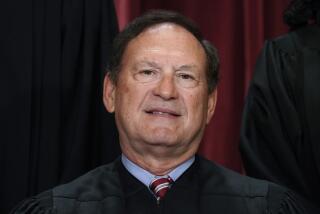Cancer Keeps Rehnquist Home, Prolongs Concerns
- Share via
WASHINGTON — Chief Justice William H. Rehnquist, heightening the uncertainty that surrounds the Supreme Court on the eve of the presidential election, announced Monday that he was undergoing chemotherapy and radiation treatment for his thyroid cancer and would not return to work this week as he had hoped.
“My plan to return to the office today was too optimistic,” Rehnquist said in a statement issued by the court. “I am continuing to take radiation and chemotherapy treatments on an outpatient basis.”
Rehnquist said that, at the suggestion of doctors, he was “continuing to recuperate at home.”
The 80-year-old Rehnquist said he was keeping up with the court’s business from home, including working on opinions in pending cases. “I am, and will continue to be, in close contact with my colleagues, my law clerks and members of the Supreme Court staff,” he said.
Despite Rehnquist’s business-as-usual comments, his cancer treatment and absence from the court highlights the near-certainty that the winning presidential candidate -- President Bush or Sen. John F. Kerry -- will select the next chief justice.
The news that Rehnquist was receiving chemotherapy strongly suggested that he had the most severe and fast-spreading form of thyroid cancer, several medical experts said.
Before his illness, Rehnquist hinted that he planned to retire sometime next year, particularly if Bush were reelected.
If he returns to the bench in the weeks ahead, he could serve and announce his retirement at the end of the court’s term in June. If he is unable to return, his absence could become a factor if any election disputes resulted in emergency appeals.
Lawyers for Democrats or Republicans are likely to challenge the counting of some votes if the outcome in a crucial state turns on unresolved ballots. They could ultimately ask the Supreme Court to intervene.
Lawyers for Bush did so four years ago after the Florida Supreme Court ordered a hand recount of the remaining untabulated punch-card ballots.
In the Florida case, Bush’s lawyers filed an emergency appeal asking the Supreme Court to halt the recount. Rehnquist led the 5-4 majority that did just that, thereby preserving Bush’s narrow victory over his Democratic opponent, Al Gore.
Rehnquist’s continued absence in the weeks ahead raises the prospect of a 4-4 deadlock in the case of election appeals, and could convince his colleagues not to intervene in any post-election dispute. That would leave intact a ruling of a lower federal appeals court.
However, the chief justice’s statement that he was working from home also could suggest that he would try to participate in the weeks ahead if emergency appeals were sent to the high court. Health permitting, Rehnquist could cast a vote without leaving his home.
If Bush wins reelection, he could nominate a new chief justice upon Rehnquist’s retirement.
If Kerry captures the White House, he could nominate a new chief justice early next year if Rehnquist were to step down.
Matters could get complicated if Bush were defeated and Rehnquist retired before Kerry’s inauguration on Jan. 20. If Bush nominated a new justice, the Senate would have to confirm the choice, and Democrats would almost surely block the move through a filibuster.
In the summer of 1968, Republicans filibustered when lame-duck President Johnson tried to elevate Justice Abe Fortas to succeed retiring Chief Justice Earl Warren. Fortas was forced to withdraw, and a newly elected President Nixon appointed Warren E. Burger to fill the post the next year.
Still, an outgoing Bush could seek to bypass the Senate and choose a new chief justice through a so-called recess appointment. Normally, such an appointee temporarily fills a vacancy and can serve for one year during the first session of the next Congress.
Such a move would almost certainly be attacked by Democrats as a political dirty trick. It is unclear whether a new president could supplant the recess appointee with his own nominee or would have to wait a year.
The disclosure that Rehnquist’s cancer was being treated with radiation and chemotherapy tended to confirm speculation by medical experts that his cancer was advanced.
Rehnquist was admitted to Bethesda Naval Hospital on Oct. 22 and the next day underwent a tracheotomy, a procedure that helps a patient breathe.
He did not have his thyroid removed, which is the standard treatment, several doctors said. The thyroid is a gland in the throat that secretes hormones that regulate metabolism.
“Chemotherapy and radiation are used against cancers that can’t be treated surgically,” said Dr. Jerome Hershman, a thyroid cancer specialist at UCLA’s Jonsson Cancer Center. “It suggests to me he has an anaplastic cancer, which is very aggressive and has a very poor prognosis.”
Dr. Jacqueline Jonklass, a thyroid specialist at Georgetown University Hospital in Washington, said the reference to chemotherapy, and not a thyroidectomy, “suggests he has an aggressive cancer. Anaplastic thyroid cancer is one of the most lethal cancers we know. It is, unfortunately, a disease without a very good treatment.”
Justice John Paul Stevens, the 84-year-old senior associate justice, presided over the court’s sessions Monday.
More to Read
Get the L.A. Times Politics newsletter
Deeply reported insights into legislation, politics and policy from Sacramento, Washington and beyond. In your inbox twice per week.
You may occasionally receive promotional content from the Los Angeles Times.











